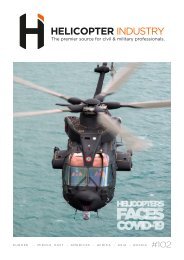Ultimate Jet #72
- No tags were found...
Create successful ePaper yourself
Turn your PDF publications into a flip-book with our unique Google optimized e-Paper software.
FLIGHTEST I 28<br />
F<br />
alconEye, the subject at hand lends itself to technical<br />
explanations but I’ll first wax poetic as much as possible and<br />
start by saying it’s an amazing system. I was given a thorough<br />
briefing by the Dassault team and their pilot-tech guru Arnaud<br />
Paulmier. Flying with FalconEye made me feel as if I stepped into a<br />
time-machine and hit fast-forward.<br />
Intuitive<br />
I tested the system on a Falcon 8X with Franco Nese and Nicolas<br />
Linehan on a blustery winter day with winds gusting up to 30 knots.<br />
While most crews would have wisely opted to remain on firm ground,<br />
most pilots are not mounted on steady steeds like a Falcon 8X nor<br />
perhaps do they have the skill-set of Dassault’s finest. The weather<br />
was challenging enough that most flight departments would have<br />
cancelled the demo but Franco and Nicolas soldiered on with on a<br />
big smile instead and nary a complaint.<br />
We launched at sunset to best sample the full capabilities of<br />
FalconEye and we were not disappointed. Even though I have<br />
flown with most Heads Up Displays (HUD) systems available in<br />
the marketplace, I don’t consider myself particularly conversant<br />
with HUD’s in general but FalconEye is so intuitive I quickly forgot<br />
I was looking through a glass pane. The information available is so<br />
complete it defies the imagination. Night and darkness surrender<br />
their mysteries to FalconEye while clouds reveal their location when<br />
the Enhanced Vision System (EVS) is called to action.<br />
WII or « Works In Ice »<br />
FalconEye is a combination system and it begins with the HUD<br />
coupled with the Enhanced Vision System (EVS). It is comprised of<br />
three major sub systems. An overhead Combiner Unit (OCU) based<br />
on LCD technology along with an Overhead Projector Unit (OPU)<br />
work together to create an electro-optical system that displays<br />
flight-critical information in symbolic form and creates an image for<br />
the pilot to see. Display symbology and the image are generated by<br />
the Computer Unit (CU). The EVS system is composed of 6 sensor<br />
cameras. There is a night sensor to detect lights in dark situations<br />
and four day-time sensors aided by a thermal sensor for terrain<br />
imaging. The EVS high resolution video feed is created by the fusion<br />
of all 6 sensors and is generated by the camera itself. This system<br />
works in ice conditions as well. Strangely, there was no acronym<br />
for this unit so I made one up-I named it WII and decreed it stands<br />
for «Works In Ice». All joking aside, the EVS works remarkably well in<br />
snowy conditions.<br />
One thing that makes this system so useful is its wide field of vision.<br />
With 40 degrees of horizontal and 30 degrees of vertical field of vision<br />
I felt none of the narrow tunnel vision I expected. The same coverage<br />
is available for the SVS system. This system is multilayered with<br />
terrain, airports depicted by their ICAO nomenclature and runways<br />
shown at the destination. Obstacles greater than 200 feet above<br />
ground level such as buildings and antennas are displayed if they are<br />
10 nautical miles from the aircraft.









